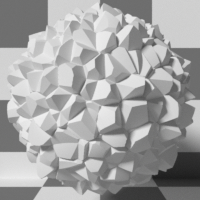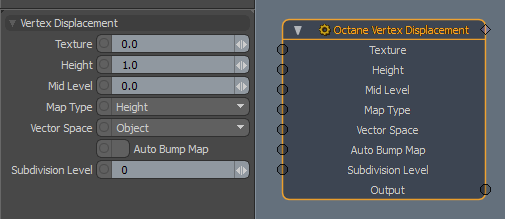
Vertex DisplacementThe process of utilizing a 2D texture map to generate 3D surface relief. As opposed to bump and normal mapping, Displacement mapping does not only provide the illusion of depth but it effectively displaces the actual geometric position of points over the textured surface. is a more robust displacement method that doesn't suffer from the same limitations as Texture Displacement. It works with all TexturesTextures are used to add details to a surface. Textures can be procedural or imported raster files. and ProjectionsMethods for orienting 2D texture maps onto 3D surfaces., including Procedurals, OSL textures, and images. Height maps and Vector Displacement maps are also supported, and can be mixed using the Vertex Displacement mixer node.


Texture - The input texture. All texture types are supported, including Images, Procedurals, and OSL textures.
Height - The displacement height in meters.
Mid Level - The image value that corresponds to no displacement. The range is always normalized to [0,1]. Set this value to 0.5 for image textures that use 50% to represent no displacement.
Map Type - Choose between Height maps and Vector Displacement maps.
Vector Space - The vector displacement map space. Only valid when Map Type is set to Vector Displacement.
Auto Bump Map - Generates an Automatic bump map to achieve fine details without requiring high subdivision levels. Only supports Height displacement maps.
Subdivision Level - The subdivision level applied to polygons using this material. Overrides the Mesh Item > Surface > Catmull-Clarke Subdivision Level. Higher subdivision levels achieve greater displacement detail, but can also increase rendering and pre-processing times.
NOTE: The Mesh > Load Cage option must be enabled for vertex displacement to work correctly in Modo.